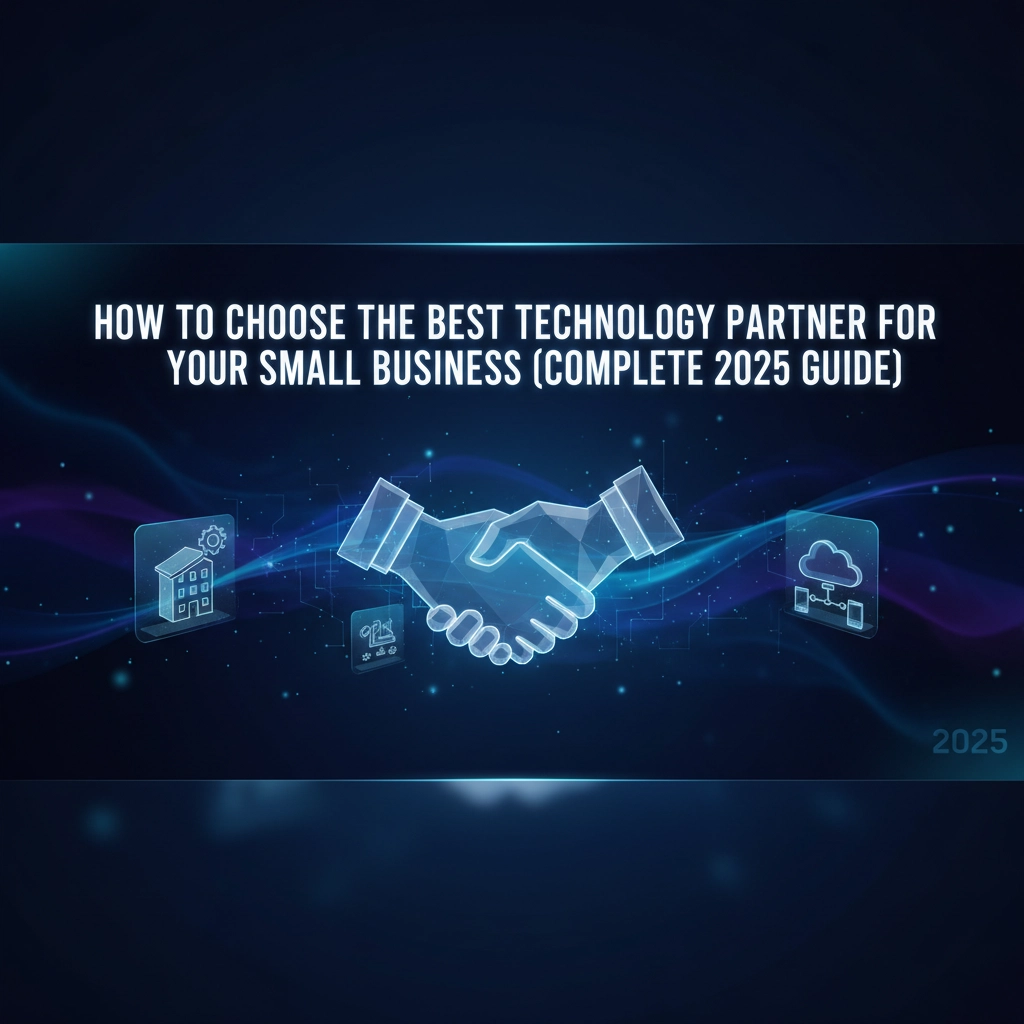November 4, 2025
How to Choose the Best Technology Partner for Your Small Business (Complete 2025 Guide)

Choosing the right technology partner can make or break your small business's digital transformation journey. In 2025, the stakes are higher than ever: your technology decisions directly impact your competitive edge, operational efficiency, and bottom line. But here's the good news: the landscape is evolving in favor of small and medium-sized businesses, with innovative partnerships creating comprehensive solutions that were once only available to enterprise-level companies.
The recent collaboration between Technicate Solutions and Datacate exemplifies this shift perfectly. By combining software development expertise with comprehensive IT services under one roof, small businesses now have access to complete technology solutions that can truly drive success. But how do you evaluate whether a tech partner is right for your business? Let's dive into the complete guide.
Why Small Businesses Need a Different Approach to Technology Partnerships
Small and medium-sized businesses face unique challenges that differ significantly from enterprise needs. You don't have the luxury of multiple vendors, dedicated IT departments, or unlimited budgets. What you need is a partner who understands that your technology solutions must be cost-effective, scalable, and comprehensive enough to handle everything from custom software development to daily IT support.
This is where the traditional model of working with separate vendors for development, IT support, cybersecurity, and cloud services falls short. Managing multiple relationships, ensuring compatibility between different systems, and coordinating updates across various providers becomes a full-time job: one that most small business owners can't afford to take on.

The Full-Service Advantage: What to Look For
When evaluating technology partners in 2025, prioritize those offering integrated services. The combination of development and IT services under one roof provides several critical advantages:
Seamless Integration: When your custom applications are built by the same team handling your IT infrastructure, compatibility issues become virtually non-existent. Your software development team understands your existing systems, network capabilities, and security requirements from day one.
Streamlined Communication: Instead of playing telephone between your app developer and IT support team, you work with one cohesive team that shares knowledge and coordinates efforts naturally.
Cost Efficiency: Bundled services typically offer better value than piecing together multiple vendors. Plus, you eliminate the hidden costs of managing multiple relationships and resolving compatibility issues.
Faster Problem Resolution: When issues arise, a unified team can diagnose problems across the entire technology stack rather than pointing fingers between vendors.
Essential Criteria for Evaluating Technology Partners
Technical Expertise and Proven Track Record
Your ideal partner should demonstrate deep expertise across multiple areas. Look for companies with proven experience in both software development and IT infrastructure management. Review their portfolio carefully: do they show successful projects similar to your needs? Can they provide case studies with measurable business outcomes?
Ask specific questions about their technical capabilities:
- What programming languages and frameworks do they specialize in?
- How do they approach cybersecurity across both custom applications and IT infrastructure?
- What cloud platforms do they work with, and how do they optimize for cost and performance?
- How do they handle data backup, disaster recovery, and business continuity?
Industry Understanding and Business Alignment
The best technology partners don't just understand code and servers: they understand business. Look for partners who take time to understand your industry, competitive landscape, and specific business challenges. They should be able to articulate how their technical solutions directly support your business objectives.
During initial conversations, pay attention to whether potential partners ask about your business goals, target customers, and growth plans. A partner focused solely on technical specifications without understanding the business context is a red flag.

Scalability and Future-Proofing
Your technology needs will evolve as your business grows. The right partner should design solutions with scalability in mind and have the capacity to grow with you. This means:
Technical Scalability: Can their applications handle increased users and data volumes? Do they use cloud-native architectures that can scale efficiently?
Team Scalability: As your needs grow, can they assign additional developers and IT professionals to your account? Do they have the depth of talent to handle complex, multi-faceted projects?
Service Scalability: Can they adapt their service offerings as your business evolves? For example, if you start as a web application client but later need mobile development or advanced analytics, can they handle the expansion?
Communication and Project Management
Clear, consistent communication is non-negotiable. Evaluate how potential partners handle project communication:
- Do they provide regular status updates and progress reports?
- How do they handle scope changes and unexpected challenges?
- What project management methodologies do they use?
- Are they responsive to questions and concerns?
The best partners use modern project management tools and methodologies like Agile development to ensure transparency and adaptability throughout the project lifecycle.
Red Flags to Avoid
The "Too Good to Be True" Pricing
Be wary of partners whose pricing is significantly below market rates. Quality technology work requires experienced professionals, proper tools, and adequate time. Unrealistically low bids often result in corner-cutting, hidden fees, or project failures.
Lack of Transparency
If a potential partner is vague about their processes, unwilling to provide references, or hesitant to discuss potential challenges, look elsewhere. The best partners are transparent about both opportunities and risks.
Limited Communication
Partners who are slow to respond during the sales process will likely have communication issues during the actual project. Pay attention to response times and quality of communication from your first interaction.

No Post-Launch Support Plan
Technology solutions require ongoing maintenance, updates, and support. Partners who focus only on initial development without a clear plan for ongoing support may leave you stranded when issues arise.
The Evaluation Process: A Step-by-Step Approach
Step 1: Define Your Requirements Clearly
Before reaching out to potential partners, document your needs comprehensively:
- What business problems are you trying to solve?
- What are your technical requirements and constraints?
- What's your timeline and budget?
- How will you measure success?
Step 2: Research and Create a Shortlist
Look for partners with relevant experience and strong reputations. Check their websites, portfolios, and client testimonials. Industry-specific review platforms like Clutch can provide valuable insights.
Step 3: Conduct Thorough Interviews
Go beyond technical capabilities. Ask about their approach to project management, how they handle challenges, and their experience with businesses similar to yours. Request references and actually contact previous clients.
Step 4: Request Detailed Proposals
Ask for comprehensive proposals that include technical approach, timeline, team structure, and pricing. Compare not just costs but the comprehensiveness and thoughtfulness of each approach.
Step 5: Start Small
Consider beginning with a smaller project or pilot program to evaluate the partnership before committing to larger initiatives. This allows you to assess their work quality, communication style, and cultural fit with lower risk.
Making the Partnership Work
Once you've selected a partner, success depends on establishing clear expectations and maintaining open communication. Define success metrics upfront, establish regular check-in schedules, and create processes for handling scope changes and unexpected challenges.
Remember that the best technology partnerships are collaborative relationships, not vendor-client transactions. Your partner should feel invested in your success and be proactive about suggesting improvements and optimizations.

The Future of Small Business Technology Partnerships
The trend toward comprehensive, integrated technology solutions will continue accelerating in 2025 and beyond. Small businesses that partner with providers offering both development and IT services gain significant advantages in terms of efficiency, cost-effectiveness, and strategic alignment.
Companies like Technicate Solutions and Datacate are leading this evolution, proving that small and medium-sized businesses don't have to compromise on quality or completeness when it comes to technology solutions. By choosing partners that understand both the technical and business sides of technology implementation, small businesses can compete more effectively and grow more efficiently.
Taking the Next Step
Choosing the right technology partner is one of the most important decisions you'll make for your business in 2025. The partnership you establish today will impact your ability to innovate, compete, and scale for years to come.
Take the time to evaluate potential partners thoroughly, ask the right questions, and choose based on long-term strategic fit rather than just immediate costs. The investment in finding the right partner will pay dividends through improved efficiency, reduced technical debt, and accelerated business growth.
Your business deserves a technology partner that can handle everything from custom application development to daily IT support, all while understanding your unique business needs and growth objectives. In 2025, that level of comprehensive service isn't just available; it's becoming the new standard for small business success.